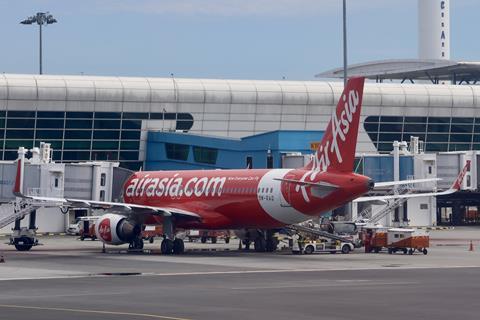The AirAsia Aviation Group intends to launch 23 new routes across its five units in Southeast Asia by end-September, a significant expansion that comes amid an improvement in earnings.
The low-cost airline group, which is in the process of being divested from parent Capital A, also expects passenger traffic recovery for the July-September period to be around 89% pre-pandemic levels, with growth led by Mainland China and India.

AirAsia group chief Bo Lingam says its “number one priority” now is to get its aircraft back in operation, while it receives new aircraft.
“We have been operating under challenging conditions, with limited aircraft availability due to delayed deliveries and a tight supply of spare parts,” he adds.
According to its fleet forecast, AirAsia expects to have 195 aircraft operating across its units in Malaysia, Thailand, Indonesia, the Philippines and Cambodia by the end of the year, 12 more jets than its forecast for the July-September quarter.
“As additional capacity returns, we will be in stronger footing to negotiate for airport and tourism incentives,” Lingam states.
The capacity and network update comes as the airline group improves its second-quarter earnings, despite “challenging” fuel price and foreign exchange conditions.
For the three months ended 30 June, AirAsia Aviation saw its revenue jump 60% year on year to MYR4.6 billion ($1 billion). It reported a positive EBITDA of MYR707 million, a significant 75% rise compared to the year-ago period.
AirAsia expects “aggressive top line growth and profitability” in the quarter ending 30 September, helped by traffic growth across its network.
Adds Lingam: “Our immediate focus remains on optimising fares and revenue yield to capitalise on latent demand while closely monitoring global fuel prices and other macro factors amidst potential geopolitical tensions in the Middle East.”
AIRASIA RETURNS TO SUBANG
Separately, AirAsia has commenced operations from Kuala Lumpur’s Subang airport, with flights to Kuching and Kota Kinabalu.
The new flights are part of airport revitalisation plans to allow jet operations at Subang, and mark a “significant milestone” for AirAsia, which began operations from the airport in 2001 but later moved to Kuala Lumpur international airport (KLIA).
The low-cost operator has also confirmed plans to establish Subang as its sixth operating hub in Malaysia, says AirAsia Malaysia managing director Fareh Mazputra.
He adds: “Reestablishing our presence here…is not only about reconnecting with our past but also about laying the foundation for our future. The airport’s strategic location, with its proximity to the city centre and surrounding suburbs, provides an optimal travel experience and greater flexibility for our guests, especially those travelling to and from East Malaysia.”
Subang was the city’s main gateway until 1998, when the larger KLIA – located further south from the city – began operations.


























